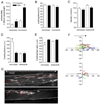LFA-1 and Mac-1 define characteristically different intralumenal crawling and emigration patterns for monocytes and neutrophils in situ
- PMID: 21037096
- PMCID: PMC3004223
- DOI: 10.4049/jimmunol.1001638
LFA-1 and Mac-1 define characteristically different intralumenal crawling and emigration patterns for monocytes and neutrophils in situ
Abstract
To exit blood vessels, most (∼80%) of the lumenally adhered monocytes and neutrophils crawl toward locations that support transmigration. Using intravital confocal microscopy of anesthetized mouse cremaster muscle, we separately examined the crawling and emigration patterns of monocytes and neutrophils in blood-perfused unstimulated or TNF-α-activated venules. Most of the interacting cells in microvessels are neutrophils; however, in unstimulated venules, a greater percentage of the total monocyte population is adherent compared with neutrophils (58.2 ± 6.1% versus 13.6 ± 0.9%, adhered/total interacting), and they crawl for significantly longer distances (147.3 ± 13.4 versus 61.8 ± 5.4 μm). Intriguingly, after TNF-α activation, monocytes crawled for significantly shorter distances (67.4 ± 9.6 μm), resembling neutrophil crawling. Using function-blocking Abs, we show that these different crawling patterns were due to CD11a/CD18 (LFA-1)- versus CD11b/CD18 (Mac-1)-mediated crawling. Blockade of either Mac-1 or LFA-1 revealed that both LFA-1 and Mac-1 contribute to monocyte crawling; however, the LFA-1-dependent crawling in unstimulated venules becomes Mac-1 dependent upon inflammation, likely due to increased expression of Mac-1. Mac-1 alone was responsible for neutrophil crawling in both unstimulated and TNF-α-activated venules. Consistent with the role of Mac-1 in crawling, Mac-1 block (compared with LFA-1) was also significantly more efficient in blocking TNF-α-induced extravasation of both monocytes and neutrophils in cremaster tissue and the peritoneal cavity. Thus, mechanisms underlying leukocyte crawling are important in regulating the inflammatory responses by regulating the numbers of leukocytes that transmigrate.
Figures







Similar articles
-
Intraluminal crawling of neutrophils to emigration sites: a molecularly distinct process from adhesion in the recruitment cascade.J Exp Med. 2006 Nov 27;203(12):2569-75. doi: 10.1084/jem.20060925. Epub 2006 Nov 20. J Exp Med. 2006. PMID: 17116736 Free PMC article.
-
Relative contribution of LFA-1 and Mac-1 to neutrophil adhesion and migration.J Immunol. 1999 Nov 1;163(9):5029-38. J Immunol. 1999. PMID: 10528208
-
Control of leukocyte rolling velocity in TNF-alpha-induced inflammation by LFA-1 and Mac-1.Blood. 2002 Jan 1;99(1):336-41. doi: 10.1182/blood.v99.1.336. Blood. 2002. PMID: 11756189
-
LFA-1 (CD11a/CD18) and Mac-1 (CD11b/CD18) distinctly regulate neutrophil extravasation through hotspots I and II.Exp Mol Med. 2019 Apr 9;51(4):1-13. doi: 10.1038/s12276-019-0227-1. Exp Mol Med. 2019. PMID: 30967528 Free PMC article.
-
Vav1 is essential for mechanotactic crawling and migration of neutrophils out of the inflamed microvasculature.J Immunol. 2009 Jun 1;182(11):6870-8. doi: 10.4049/jimmunol.0803414. J Immunol. 2009. PMID: 19454683 Free PMC article.
Cited by
-
Leukocyte transmigration and longitudinal forward-thrusting force in a microfluidic Transwell device.Biophys J. 2021 Jun 1;120(11):2205-2221. doi: 10.1016/j.bpj.2021.03.037. Epub 2021 Apr 8. Biophys J. 2021. PMID: 33838136 Free PMC article.
-
A Genetic Model of Constitutively Active Integrin CD11b/CD18.J Immunol. 2020 Nov 1;205(9):2545-2553. doi: 10.4049/jimmunol.1901402. Epub 2020 Sep 16. J Immunol. 2020. PMID: 32938725 Free PMC article.
-
Percutaneous Laser Ablation of Unifocal Papillary Thyroid Microcarcinoma: Utility of Conventional Ultrasound and Contrast-Enhanced Ultrasound in Assessing Local Therapeutic Response.World J Surg. 2018 Aug;42(8):2476-2484. doi: 10.1007/s00268-018-4500-6. World J Surg. 2018. PMID: 29488064
-
Macrophage-endothelial cell crosstalk orchestrates neutrophil recruitment in inflamed mucosa.J Clin Invest. 2023 Aug 1;133(15):e170733. doi: 10.1172/JCI170733. J Clin Invest. 2023. PMID: 37261911 Free PMC article.
-
Leukocyte arrest: Biomechanics and molecular mechanisms of β2 integrin activation.Biorheology. 2015;52(5-6):353-77. doi: 10.3233/BIR-15085. Biorheology. 2015. PMID: 26684674 Free PMC article. Review.
References
-
- Smith JA. Neutrophils, host defense, and inflammation: a double-edged sword. J Leukoc Biol. 1994;56:672–686. - PubMed
-
- Muller WA, Randolph GJ. Migration of leukocytes across endothelium and beyond: molecules involved in the transmigration and fate of monocytes. J Leukoc Biol. 1999;66:698–704. - PubMed
-
- Kansas GS. Selectins and their ligands: current concepts and controversies. Blood. 1996;88:3259–3287. - PubMed
-
- Ley K, Allietta M, Bullard DC, Morgan S. Importance of E-selectin for firm leukocyte adhesion in vivo. Circ Res. 1998;83:287–294. - PubMed
Publication types
MeSH terms
Substances
Grants and funding
LinkOut - more resources
Full Text Sources
Other Literature Sources
Research Materials

